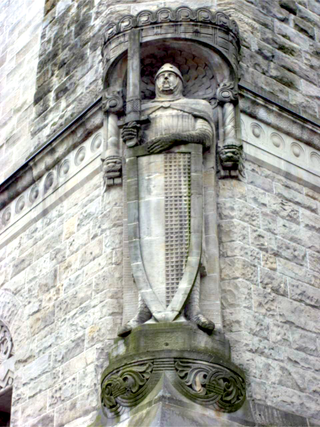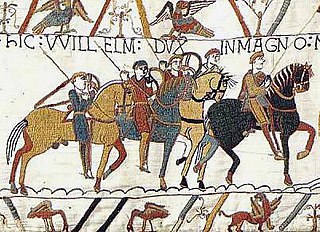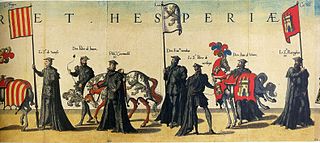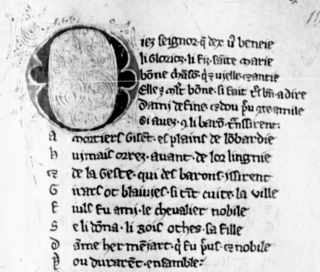
Turold is one of the tituli on the Bayeux tapestry. Which of two figure is being identified is uncertain, as is the identification of the namesake with a known historical person. He may be the same person as Turold of Rochester.

Turold is one of the tituli on the Bayeux tapestry. Which of two figure is being identified is uncertain, as is the identification of the namesake with a known historical person. He may be the same person as Turold of Rochester.
The tapestry mentions a small number of important figures by name. When they are mentioned, their name is depicted directly above their head. For this reason, some believe that Turold is not the messenger in red who would later become Constable of Bayeux, but the man who appears to have a form of dwarfism and is holding the messenger's horse's reins. [1] It should also be noted that Turold was a common name at the time of the creation of the tapestry, and it is possible that both figures bear the name "Turold".
The dwarf figure appears to be a jongleur or minstrel based on his wide breeches and flared tunic, leading some to further conjecture that he could be Turoldus as mentioned in the Chanson de Roland. Jongleurs of this era could be extremely skilled, therefore could reasonably be the mysterious author or performer of that poem. However, as Turold and its derivatives were popular names at the time of the creation of the oldest surviving copy of the Chanson de Roland, it is also possible the Turoldus mentioned is a third and entirely different person than those shown on the Bayeux Tapestry. This is the prevailing hypothesis among modern historians. [1]
Turold may refer to Walter Sans Avoir, Taillefer, and Walter III of the Vexin, the father of Walter Tirel depicted as a dwarf due to his descent from the Nibelungids, the old Counts of Autun. These Counts often served as Dukes of Burgundy, Aquitaine, and Provence in Carolingian times and may have inspired the chanson. The tapestry may have been commissioned by Edith of Wessex, Walter's aunt.

Harold Godwinson, also called Harold II, was the last crowned Anglo-Saxon English king. Harold reigned from 6 January 1066 until his death at the Battle of Hastings on 14 October 1066, the decisive battle of the Norman Conquest. Harold's death marked the end of Anglo-Saxon rule over England. He was succeeded by William the Conqueror.

The Battle of Hastings was fought on 14 October 1066 between the Norman-French army of William, Duke of Normandy, and an English army under the Anglo-Saxon King Harold Godwinson, beginning the Norman Conquest of England. It took place approximately 7 mi (11 km) northwest of Hastings, close to the present-day town of Battle, East Sussex, and was a decisive Norman victory.

The Bayeux Tapestry is an embroidered cloth nearly 70 metres long and 50 centimetres tall that depicts the events leading up to the Norman Conquest of England in 1066, led by William, Duke of Normandy challenging Harold II, King of England, and culminating in the Battle of Hastings. It is thought to date to the 11th century, within a few years of the battle. Now widely accepted to have been made in England, perhaps as a gift for William, it tells the story from the point of view of the conquering Normans and for centuries has been preserved in Normandy.

Eustace II,, also known as Eustace aux Grenons, was Count of Boulogne from 1049 to 1087. He fought on the Norman side at the Battle of Hastings, and afterwards received large grants of land forming an honour in England. He is one of the few proven companions of William the Conqueror. It has been suggested that Eustace was the patron of the Bayeux Tapestry. His second son Godfrey of Bouillon was a preeminent leader of the First Crusade, and the first ruler of the Kingdom of Jerusalem.

Tapestry is a form of textile art, traditionally woven by hand on a loom. Normally it is used to create images rather than patterns. Tapestry is relatively fragile, and difficult to make, so most historical pieces are intended to hang vertically on a wall, or sometimes horizontally over a piece of furniture such as a table or bed. Some periods made smaller pieces, often long and narrow and used as borders for other textiles. Most weavers use a natural warp thread, such as wool, linen, or cotton. The weft threads are usually wool or cotton but may include silk, gold, silver, or other alternatives.

Roland was a Frankish military leader under Charlemagne who became one of the principal figures in the literary cycle known as the Matter of France. The historical Roland was military governor of the Breton March, responsible for defending Francia's frontier against the Bretons. His only historical attestation is in Einhard's Vita Karoli Magni, which notes he was part of the Frankish rearguard killed in retribution by the Basques in Iberia at the Battle of Roncevaux Pass.

The Song of Roland is an 11th-century chanson de geste based on the deeds of the Frankish military leader Roland at the Battle of Roncevaux Pass in AD 778, during the reign of the Emperor Charlemagne. It is the oldest surviving major work of French literature. It exists in various manuscript versions, which testify to its enormous and enduring popularity in Medieval and Renaissance literature from the 12th to 16th centuries.

The chanson de geste is a medieval narrative, a type of epic poem that appears at the dawn of French literature. The earliest known poems of this genre date from the late 11th and early 12th centuries, shortly before the emergence of the lyric poetry of the troubadours and trouvères, and the earliest verse romances. They reached their highest point of acceptance in the period 1150–1250.

Bayeux is a commune in the Calvados department in Normandy in northwestern France.
The Matter of France, also known as the Carolingian cycle, is a body of medieval literature and legendary material associated with the history of France, in particular involving Charlemagne and the Paladins. The cycle springs from the Old French chansons de geste, and was later adapted into a variety of art forms, including Renaissance epics and operas. Together with the Matter of Britain, which concerned King Arthur, and the Matter of Rome, comprising material derived from and inspired by classical mythology, it was one of the great European literary cycles that figured repeatedly in medieval literature.
In the Middle Ages, Termagant or Tervagant was the name of a god that some European Christians believed Muslims worshipped. It originates in the eleventh-century Song of Roland

Taillefer was the surname of a Norman jongleur (minstrel), whose exact name and place of birth are unknown. He travelled to England during the Norman conquest of England of 1066, in the train of William the Conqueror. At the Battle of Hastings, Taillefer sang the Chanson de Roland at the English troops while juggling with his sword. An English soldier ran out to challenge him and was killed by Taillefer, who then charged the English lines alone while singing and was engulfed, killing at least four more English in the process. Taillefer is not depicted, by name at least, on the Bayeux Tapestry because of this most people believe that this is a story.
Turoldus, or Turold, is the name traditionally given to the author of the 11th-century French poem the Song of Roland. Efforts to make a convincing further identification of the identity of Turoldus have failed. The Latin form Turoldus is equivalent to the personal name Thorold.

William the Conqueror had men of diverse standing and origins under his command at the Battle of Hastings in 1066. With these and other men he went on in the five succeeding years to conduct the Harrying of the North and complete the Norman conquest of England.

The Tapestry of Creation or Girona Tapestry is a Romanesque panel of needlework from the 11th century, housed in the Museum of the Cathedral of Girona, Catalonia, Spain. Measuring 3.65 m × 4.70 m of wool and linen, contemporary scholars are still debating its patronage and intended function in the Church. It is organized in concentric circles surrounded by a border depicting a series of theological scenes related with the Christian creation myth as well as a description of the yearly calendar. The righthand border and bottom third of the fabric is lost, but it is believed that the missing sections held a continuation of the months as well as a space describing the discovery of the True Cross.

Turstin fitz Rolf, also known as Turstin le Blanc and Tustein fitz Rou played a prominent role in the Norman conquest of England and is regarded as one of the few proven companions of William the Conqueror at the Battle of Hastings in 1066.

The Bayeux Tapestry tituli are Medieval Latin captions that are embroidered on the Bayeux Tapestry and describe scenes portrayed on the tapestry. These depict events leading up to the Norman conquest of England concerning William, Duke of Normandy, and Harold, Earl of Wessex, later King of England, and culminating in the Battle of Hastings.

The first instance of a figure of the lion as symbol of the Kingdom of León is found in minted coins of Alfonso VII, called the Emperor (1126–1157). Until then, the cross had a preponderant position on documents and coins of Leonese monarchs since that reign the cross was gradually displaced by the lion. The Spanish historian and heraldist Martín de Riquer explained that the lion was already used as heraldic emblem in 1148. At the end of the reign of Alfonso VII, the figure of this animal began to appear on royal documents as personal device of the monarch and became pervasive during reigns of Ferdinand II (1157-1188) and Alfonso IX (1188-1230).

Jordain de Blaivies is an Old French chanson de geste written in decasyllables around 1200. It is an adventure story, largely inspired by the ancient story of Apollonius of Tyre. It survives in a single manuscript. The original was never popular, but it was reworked into a different metre and also adapted into prose in the 15th century. The prose version was printed with illustrations in 1520.
Turold may refer to: